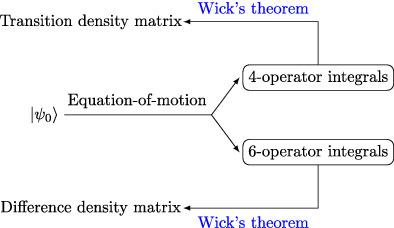当前位置:
X-MOL 学术
›
Int. J. Quantum Chem.
›
论文详情
Our official English website, www.x-mol.net, welcomes your
feedback! (Note: you will need to create a separate account there.)
A comprehensive, self‐contained derivation of the one‐body density matrices from single‐reference excited‐state calculation methods using the equation‐of‐motion formalism
International Journal of Quantum Chemistry ( IF 2.3 ) Pub Date : 2020-01-23 , DOI: 10.1002/qua.26110 Thibaud Etienne 1
International Journal of Quantum Chemistry ( IF 2.3 ) Pub Date : 2020-01-23 , DOI: 10.1002/qua.26110 Thibaud Etienne 1
Affiliation

|
In this contribution we review in a rigorous, yet comprehensive fashion the assessment of the one-body reduced density matrices derived from the most used single-reference excited-state calculation methods in the framework of the equation-of-motion formalism. Those methods are separated into two types: those which involve the coupling of a deexcitation operator to a single-excitation transition operator, and those which do not involve such a coupling. The case of many-body auxiliary wave functions for excited states is also addressed. For each of these approaches we were interested in deriving the elements of the one-body transition and difference density matrices, and to highlight their particular structure. This has been accomplished by applying a decomposition of integrals involving one-determinant quantum electronic states on which two or three pairs of second quantization operators can act. Such a decomposition has been done according to a corollary to Wick's theorem, which is brought in a comprehensive and detailed manner. A comment is also given about the consequences of using the equation-of-motion formulation in this context, and the two types of excited-state calculation methods (with and without coupling excitations to deexcitations) are finally compared from the point of view of the structure of their transition and difference density matrices.
中文翻译:

使用运动方程形式从单参考激发态计算方法全面、独立地推导出整体密度矩阵
在这篇文章中,我们以严格而全面的方式回顾了对从运动方程形式主义框架中最常用的单参考激发态计算方法得出的整体密度矩阵的评估。这些方法分为两类:一种是将去激发算子耦合到单激发转移算子,另一种是不涉及这种耦合。还讨论了激发态的多体辅助波函数的情况。对于这些方法中的每一种,我们都有兴趣推导出单体过渡矩阵和差分密度矩阵的元素,并突出它们的特定结构。这是通过应用涉及一个行列式量子电子态的积分分解来实现的,两对或三对第二量子化算子可以作用于这些量子电子态。这种分解是根据 Wick 定理的推论完成的,该定理以全面和详细的方式进行。还对在此上下文中使用运动方程公式的后果进行了评论,并最终从以下角度比较了两种激发态计算方法(有和没有耦合激发与去激发)它们的过渡和差分密度矩阵的结构。
更新日期:2020-01-23
中文翻译:

使用运动方程形式从单参考激发态计算方法全面、独立地推导出整体密度矩阵
在这篇文章中,我们以严格而全面的方式回顾了对从运动方程形式主义框架中最常用的单参考激发态计算方法得出的整体密度矩阵的评估。这些方法分为两类:一种是将去激发算子耦合到单激发转移算子,另一种是不涉及这种耦合。还讨论了激发态的多体辅助波函数的情况。对于这些方法中的每一种,我们都有兴趣推导出单体过渡矩阵和差分密度矩阵的元素,并突出它们的特定结构。这是通过应用涉及一个行列式量子电子态的积分分解来实现的,两对或三对第二量子化算子可以作用于这些量子电子态。这种分解是根据 Wick 定理的推论完成的,该定理以全面和详细的方式进行。还对在此上下文中使用运动方程公式的后果进行了评论,并最终从以下角度比较了两种激发态计算方法(有和没有耦合激发与去激发)它们的过渡和差分密度矩阵的结构。











































 京公网安备 11010802027423号
京公网安备 11010802027423号